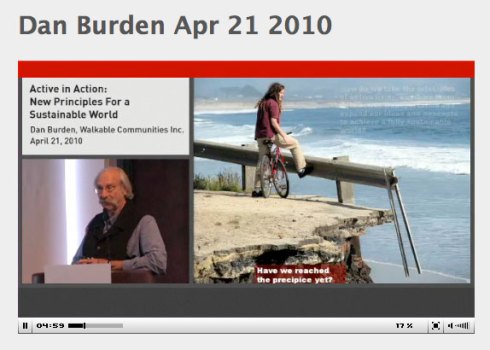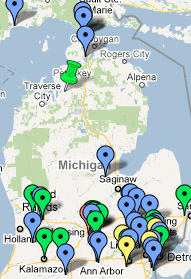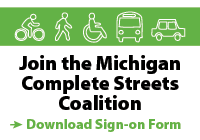You are currently browsing the category archive for the ‘Resources’ category.
Reported by Paul Lamoureux, Northville Resident
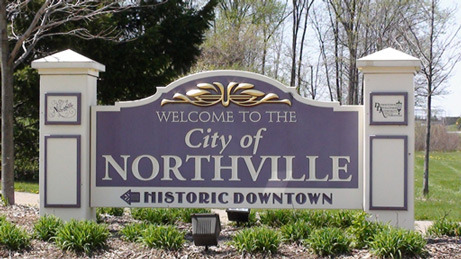
With unanimous accord, the Northville City Council adopted a complete streets resolution at its regular meeting on Monday, June 20. The measure was hailed by its author and initial proponent, City Manger Patrick Sullivan, as a necessary first step toward the establishment of a comprehensive non-motorized master plan designed to link Northville residents with nearby communities of Novi and Plymouth. It turns out Mr. Sullivan has prior, job-related experience with non-motorized infrastructure and has experienced first hand the positive community and economic benefits when a community accommodates all modes of transportation.
Several interesting facts emerged during the discussion of the resolution. Novi, with its own complete streets resolution, was cited as an example of a community benefiting from its long-standing non-motorized plan whose residents have long sought better access to commercial downtown Northville. Residents of both communities also seek a method to bike and walk to nearby Maybury State Park, a presently unsupported route and primary goal for the future. Finally, some expressed support for a better, biker-friendly connection between downtown Northville and Hines Park terminating at the city’s southern border.
A pair of Northville resident League of Michigan Bicyclists (LMB) members first approached the City Manager just a few short months ago to communicate the complete streets message. The city then availed itself of the resources provided by micompletestreets.org and the Michigan Municipal League. Upon passage of the resolution, City Council expressed their interest in further support from LMB in the drafting and implementation of the non-motorized master plan and expressed their gratitude for their leadership thus far in the process.
Marquette, Ludington, Lake Isabella, Acme Twp. and Owosso join the growing list of supportive communities!
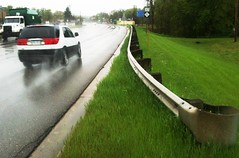
A roadway in need of complete streets in Acme Township. (photo by glhjr)
While we have been a little behind in updating this site the past few weeks, it certainly doesn’t mean there hasn’t been news worth posting about complete streets in Michigan. In fact, we are pleased to report that there have been five complete streets resolutions adopted across the state recently.
On May 9th, both the Cities of Marquette and Ludington adopted complete streets resolutions at their respective City Council meetings. The Mining Journal and the Ludington Daily News both covered the passage of these resolutions.
We also received word this month from Lake Isabella Village Manager Tim Wolff that their Village Council also adopted a complete streets resolution.
As reported on My Wheels are Turning, Acme Township became the first community in Grand Traverse County to endorse Complete Streets at their June 7th Board of Trustees meeting. They join a handful of other townships across the state who have also recently adopted complete streets resolutions. While we are extremely encouraged by the action of these communities, it still remains to be seen what sort of impact these policies will ultimately have since county road commissions actually are the ones who have jurisdiction over roads within townships. Ultimately we hope that we are seeing the beginning of a fruitful dialog between Michigan’s 1200+ townships and the 80+ county road commissions.
It also looks like we might see more complete streets policies coming out of northern Michigan in the near future. According to the Petoskey News Northeast Michigan Council of Governments and Michigan Trails & Greenways Alliance are cooperating to offer complete streets training sessions in Emmet and Alpena Counties at the end of this month.
And lastly, as we reported yesterday, Owosso also recently adopted a complete streets resolution. This brings Michigan to a total of 38 known local resolutions and six ordinances in addition to our statewide law. According to Holly Madill, Complete Streets Project Coordinator for the Michigan Department of Community Health, approximately 2,659,080 people, 27% of Michigan’s population now lives in a community that has endorsed complete streets either through a resolution or ordinance.
View Resolutions:
Over the last four years, New York City has seen a transportation renaissance on its streets, striking a better balance by providing more space for walking, biking, and transit.
As with any departure from the status quo, it can take a while for everyone to grow accustomed to the changes. So Streetfilms decided to look at three of NYC’s most recent re-designs — Columbus Avenue, First and Second Avenues, and Prospect Park West — and show how pedestrians, cyclists, and drivers benefit from safer, calmer streets. We talked to transportation engineers with decades of experience, elected leaders, community board members, people on the street, and business owners to get their take on the new configurations.
By Scott T. Clein, P.E., LEED AP
Reposted with permission from the Michigan Municipal League’s May/June issue of The Review magazine
Pedestrian-friendly … walkable … You’ve most likely heard, and used, these terms when describing the future vision of your community. You’ve also likely heard about Complete Streets and assumed it was the same thing.
Technically you’re right…and wrong. While Complete Streets initiatives do improve the walkability of roadways, the concept includes so much more. Before your community takes a dive into the Complete Streets waters, you need to understand whether or not you’ll need a life vest.
In 2010, Michigan joined a growing list of states that enacted legislation related to Complete Streets. Two bills passed that added the phrase to the legislative vernacular and requires the Michigan Department of Transportation to create a Complete Streets policy that serves as a model for communities.
But what is the concept really all about? Below are common definitions that should be considered during Complete Streets planning and discussions.
COMPLETE STREETS is a movement that designs and operates roadway corridors promoting safe access for all users. Roadways, therefore, should accommodate vehicles, transit, bicyclists, and pedestrians of all ages and abilities.
UNIVERSAL ACCESSIBILITY emerged as an offshoot of barrier-free design. It’s the idea that good design must take into account the age and ability of all users from the beginning, even if it means exceeding minimum standards to allow for a better use of space.
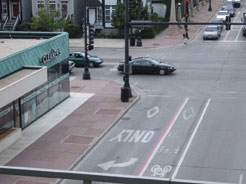 GREEN STREETS encourages sustainability in the design and construction of roadways by using the latest best management practices, such as rain gardens for improving stormwater quality.
GREEN STREETS encourages sustainability in the design and construction of roadways by using the latest best management practices, such as rain gardens for improving stormwater quality.
LIVING STREETS states pedestrians must be properly included in transportation designs. It goes beyond simply adding sidewalks to include active use of the corridor, such as outdoor dining and sales, and neighborhood festivals.
With a clearer understanding of Complete Streets improvements, here are five common myths that may get in the way of planning and implementation.
Myth 1: It’s expensive.
Designs in line with Complete Streets philosophies don’t have to cost a lot, especially when included in annual capital improvement projects. Most communities have existing funding for road maintenance and related upgrades. When resurfacing a roadway, for example, implement bike lanes for little to no added cost.
This piece-by-piece approach may seem out of place when attempting to promote connectivity, but it mimics road maintenance approaches and allows the largest benefits from shrinking budgets.
Myth 2: On-street bike lanes are unsafe.
On the contrary, studies show that on-street bike lanes, when properly marked and signed, are safer for bicyclists and pedestrians than sidewalks.
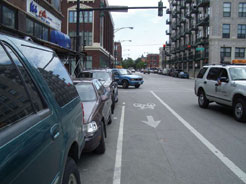 The Transportation Research Board published a study by William Moritz at the University of Washington referencing the Relative Danger Index, which measures bicycle-accident frequency to distance traveled. A higher number represents a greater danger. Sidewalks have an RDI of 5.30 while streets with dedicated bike lanes have an RDI of 0.50.
The Transportation Research Board published a study by William Moritz at the University of Washington referencing the Relative Danger Index, which measures bicycle-accident frequency to distance traveled. A higher number represents a greater danger. Sidewalks have an RDI of 5.30 while streets with dedicated bike lanes have an RDI of 0.50.
Clearly, it’s a misperception that bicyclists are at greater risk on roadway bike lanes. This on-street myth is also perpetuated by the notions that drivers won’t change their driving habits in the presence of a bicyclist and that roadways are only built for vehicles.
Myth 3: It’s only for urban communities.
Urban areas will undoubtedly benefit the most from Complete Streets improvements because of dense pedestrian activity. However, let’s imagine a rural suburban community that has, during the last 30 years, shifted from primarily agricultural land uses to single-family residential developments.
Typically, these developments are islands surrounded by farmland with intermittent access to an open-shoulder country road. They are not truly connected with other neighborhoods and do not allow residents to safely walk or bicycle outside of their subdivision.
Now imagine the same two-lane country road with a paved bike lane along the shoulder. Then add a large shared-use pathway beside the right-of-way line for pedestrians and less-accomplished bicyclists. The result is safely linked subdivisions and a community that is making a dynamic statement about its values.
Myth 4: It negatively impacts traffic flow.
Well…yes, it might. Accommodations for pedestrians and bicyclists may increase driver delay or reduce vehicle speeds. But this is not always a bad thing.
Pedestrian spaces and dedicated bike lanes can create an inviting atmosphere. In addition to promoting a healthier lifestyle, this can help foster the spirit that cool communities seem to have. This so-called “it” factor entices people to live in a neighborhood or city center and directly translates into positive community economic development and financial sustainability.
While there can be repercussions, such as altered traffic patterns that negatively impact surrounding streets, transportation engineers must look at their network holistically and reconsider pavement geometry to encourage safe driving.
Myth 5: “We ARE a walkable community, so this won’t change our plans.”
Some communities have embraced the Complete Streets concept. Still, disagreements between planning and engineering staffs continue largely because of these myths. Simply being walkable does not make a Complete Street. What about ADA compliance and other street amenities? Significant opportunities spring from combining the power of the planning, engineering, and economic development areas of local government.
Consider an engineering department that actively promotes the construction of smaller roadways to incorporate bike lanes, wide sidewalks, and universal design principles. What if the planning department aligns these improvements with zoning ordinances to encourage mixed-use developments with outdoor dining and pedestrian-scale amenities? Now, the economic development director has added firepower to actively recruit businesses and developments. Uniting these groups can unleash the powerful potential to positively impact a community.
This last point is the overarching benefit that must be understood about Complete Streets. When properly infused into a community, a Complete Streets mentality can help unite economic development, land planning, and transportation engineering for bettering the overall quality of life. All community leaders would benefit from understanding the definitions and implications, but also keeping in mind the myths discussed. With the proper perspective and conviction, Complete Streets can make every Michigan community a better place to live.
Giffels-Webster
Giffels-Webster Engineers, Inc. is a civil engineering, surveying, planning, and landscape architecture firm with a 55-year history of serving municipalities and governmental agencies throughout Michigan.
For more on Giffels-Webster, visit www.giffelswebster.com
Scott T. Clein, P.E., LEED AP is an associate at Giffels-Webster.
You may reach him at 313-962-4442 or [email protected].
In response to the successful passage of Michigan’s Complete Streets legislation, and increasing demand from interested communities and organizations, the Healthy Kids, Healthy Michigan (HKHM) Coalition, Michigan Department of Community Health (MDCH), and Michigan Trails and Greenways Alliance (MTGA) partnered to develop the Complete Streets Institute.
The Complete Streets Institute is a comprehensive and standardized 5‐module training program designed to increase awareness of complete streets principles, support local advocacy efforts, and provide practical, realistic instructions and techniques to help communities create, adopt, and implement Complete Streets policies and projects. The 5‐module Complete Streets Institute training curriculum was designed to cover all aspects Complete Streets, from introduction of the concept (Module 1) to design applications in your community (Module 5). You pick the modules YOUR community needs to move ahead with success. See the PDF below for more details.
As we reported on October 1, MDOT’s appropriation in the 2011 transportation budget included boilerplate language related to the Transportation Enhancement (TE) Program and Complete Streets in Section 321 that states,
“In evaluating and awarding enhancement grants, the department shall give preference to applicants which have adopted complete streets policies. In addition, the department shall give preference to enhancement grant applications which further complete streets policy objectives. The department shall report to the house and senate appropriations subcommittees on transportation, and the house and senate fiscal agencies, on or before March 1, 2011, on the specific actions taken to comply with the intent of this section.”
Complete Streets was an easy fit into TE Program criteria as Complete Streets objectives and TE projects are both aimed at producing an enhanced transportation network that plays an important role in the livability of our communities. The Complete Streets legislation advanced the importance of cooperation and coordination among transportation agencies and stakeholders to consider the context of the area and stakeholder needs when developing transportation projects.
Amber Thelen, MDOT’s TE Program Manager said “The TE Program looks forward to the successful transportation projects and potential TE projects that will come from this type of project development process.”
As a result, MDOT has updated the TE project competitiveness factors to include Complete Streets. Specifically, the following items were added as factors that make a project competitive for TE funding:
- “Projects identified as a result of a community’s Complete Streets stakeholder involvement process.”
- “Projects supporting a community’s Complete Streets policy…”
These updated factors are included on page 2 of the, “Project Competitiveness Details” document found at www.michigan.gov/tea.
MDOT has also proposed changes to their updated online grant application per this screen shot. The updated online grant application system will be implemented next year. In the meantime, applicants who have Complete Streets policies are asked to provide information about their policy and how the proposed TE project supports this policy within “Attachment A” (the narrative section) of the current online grant application.
Applicants are encouraged to discuss their proposed project with a grant coordinator before starting an application. A map and contact information for the grant coordinators is available at www.michigan.gov/tea, under “Contact Us.”
Questions can be directed to:
Amber Thelen
TE Program Manager
Michigan Department of Transportation Office of Economic Development
(517) 241-1456
[email protected]
Want to know which federal funding program is right for your bicycling or walking project?
Check out this federal program factsheet from our friends at America Bikes! Also see LMB’s Toolkit article with more details on additional funding sources to consider for your bicycling or walking project.
NOTE: The following letter was sent to all MDOT employees on August 5, 2010 by Director Steudle. A PDF version of this letter can be downloaded here.

August 5, 2010
What Complete Streets means for MDOT and transportation in Michigan
“Change has a considerable psychological impact on the human mind. To the fearful, it is threatening because it means that things may get worse.
To the hopeful, it is encouraging because things may get better. To the confident, it is inspiring because the challenge exists to make things better.”
– King Whitney Jr., 1967
These words about change are as true today as they were in 1967. On Aug. 1, Gov. Granholm signed into law Complete Streets legislation to advance cooperation and coordination among transportation and local governmental agencies: Public Act 135, which amends Public Act 51 of 1951 governing the expenditure of state transportation funding; and Public Act 134, which amends the Michigan Planning Enabling Act. While it might be tempting to attribute the passage of these bills to pressure from one group or another, it is worth noting that both bills passed the Michigan House and Senate by wide margins: 85-21 and 31-0, respectively.
Here is a summary of the changes to Act 51 under PA 135:
Revisions to Act 51, Section 10(k)
- Requires counties, cities, villages, and MDOT to consult with one another when planning a nonmotorized project affecting a transportation facility that belongs to the other.
- Requires Section 10(k) improvements meet accepted practices or established best practices.
- Requires Act 51 agencies to notify one another when their five-year nonmotorized programs are finalized.
New Act 51 Section 10(p)
- Requires the State Transportation Commission (STC), within two years, to adopt a Complete Streets policy for MDOT, and to develop model Complete Streets policies for use by others.
- Requires state and local agencies to consult and agree on how to address Complete Streets before submitting the Five-Year Program to the STC (exempts anything in an approved multi-year capital plan approved before July 1).
- Allows MDOT to provide technical assistance and coordination to local agencies in the development and implementation of their policies.
- Requires MDOT to share expertise in nonmotorized and multi-modal planning in the development of projects within municipal boundaries (“municipal” refers to townships, counties, cities or villages - so just about anywhere).
- Allows agencies to enter into agreements with one another to provide maintenance for projects constructed to implement a Complete Streets policy.
- Creates a Complete Streets Advisory Council within MDOT, appointed by the governor, to advise the STC and local agencies in the implementation of Complete Streets.
Amendments to the Michigan Planning Enabling Act
- Modifies the definition of “streets” to specifically include all legal users.
- Expands the elements that may be included in a master plan to encompass all transportation systems that move people and goods.
- Specifies that transportation improvements identified in a plan are appropriate to the context of the community and considers all legal users of the public right of way.
- The means for implementing transportation elements of the master plan in cooperation with applicable county road commission or MDOT.
The new laws will influence how we work with virtually every township, county, city, and village in the state. In the coming weeks, I will convene an interdisciplinary work group within MDOT to examine how the new law will affect our processes and resources. If you are asked to participate, I ask that you embrace it as an opportunity to improve how we work with our partners to deliver transportation services in Michigan.
The transportation world is changing. We can face this change fearfully, or with confidence. In my five years as director, we have faced many challenges, adapted to change, and are a better organization for doing so. I am confident we can rise to the challenge of implementing the new Complete Streets law – in letter and spirit – and emerge a stronger organization, and ultimately, a better state.
Hi everyone! Check out our updated Resources section of the website. It includes brief, two-page fact sheets about the benefits of Complete Streets policies, as well as additional links to more technical reports and studies.

